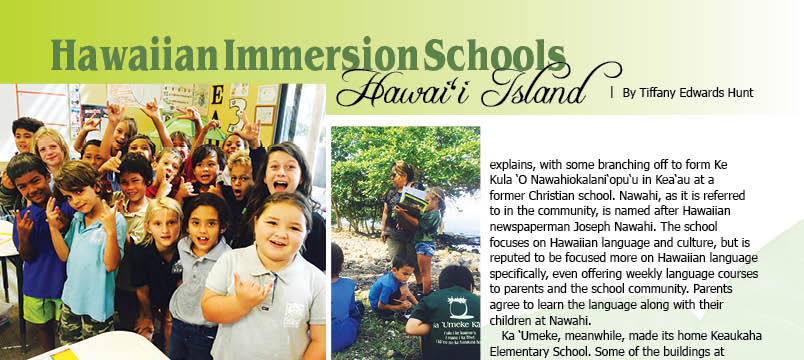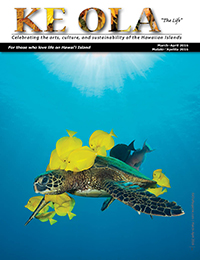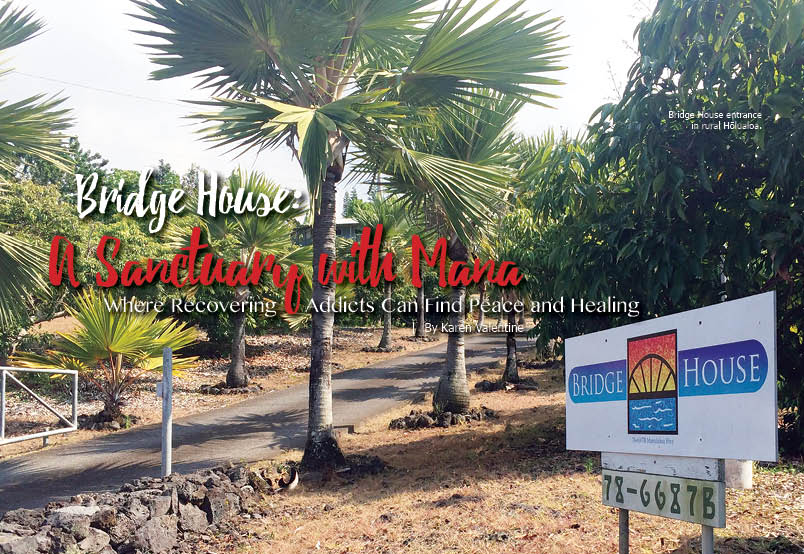
Hawaiian Immersion Schools: on Hawai‘i Island
 Editor’s note: This is the second article in a series about the 15 charter schools on Hawai‘i Island. In the last issue, Ke Ola Magazine introduced these alternative public schools that parents and children are choosing for their curricula, which are either project based or Hawaiian language and culture based, or a combination.
Editor’s note: This is the second article in a series about the 15 charter schools on Hawai‘i Island. In the last issue, Ke Ola Magazine introduced these alternative public schools that parents and children are choosing for their curricula, which are either project based or Hawaiian language and culture based, or a combination.
By Tiffany Edwards Hunt
Ka ‘Umeke Kā‘eo Hawaiian Immersion School was one of the first immersion schools in the state when it opened as “a school within a school” in Keaukaha in 1987. Beginning as a Department of Education Hawaiian Immersion program, the program evolved and was established as a charter school in 2001. Now it has expanded to a campus on leased Kamehameha Schools property down the road from Keaukaha Elementary School, at 1500 Kalanianaole Ave., near Carlsmith Beach Park and the ponds.
It started out with kindergarten, then first grade, then second grade, each year “pushing for resources” to be able to teach children the Hawaiian language in the public school setting.
“When the opportunity for a charter school happened,” with the passage of the 1999 Charter School Act, Ka ‘Umeke founders “joined the charge to have more autonomy,” recalls Olani Lilly, the po‘okumu, or administrator for Ka ‘Umeke for the last five years.
When Ka ‘Umeke went independent, (prior to becoming chartered) the school within the school “kinda split,” Olani explains, with some branching off to form Ke Kula ‘O Nawahiokalani‘opu‘u in Kea‘au at a former Christian school. Nawahi, as it is referred to in the community, is named after Hawaiian newspaperman Joseph Nawahi. The school focuses on Hawaiian language and culture, but is reputed to be focused more on Hawaiian language specifically, even offering weekly language courses to parents and the school community. Parents agree to learn the language along with their children at Nawahi.
Ka ‘Umeke, meanwhile, made its home Keaukaha Elementary School. Some of the buildings at Keaukaha Elementary School were procured and built for the Hawaiian immersion school. The two schools co-mingled together nicely for many years. Yet all good things inevitably come to an end.
“Unfortunately, when we converted to a charter school, there was no agreement on facilities,” Olani explains. “At the end of school year 2016-2017, we’re basically being forced to leave.”
Ka ‘Umeke has its campus down the road for third to 12th graders. The ones to be displaced are the kindergarteners through second graders.
“Every year we’ve gone with it, because we feel like Keaukaha is our community. We’re one with it, allowing for the expansion of Keaukaha.”
On a tour of the classrooms at Keaukaha Elementary School, Olani points out the buildings that were erected on the traditional DOE campus for the charter school and also that Keaukaha’s new cafeteria was budgeted and built using the population numbers of both schools combined.
Ka ‘Umeke’s problem stems from the fact that, while the 1999 Charter School Act allowed for these non-traditional schools, they didn’t address facilities for these schools. DOE gives all the charter schools in the state funding on a per-pupil basis, like it does for all traditional DOE schools, but doesn’t provide a building to rent, lease, or buy.
The charter schools have nonprofit arms with boards intended to fundraise for facilities. The Hawaiian immersion schools have an advantage over other charter schools in that most of them have relationships with Kamehameha Schools and Office of Hawaiian Affairs, providing grants and leases for land.
Ka ‘Umeke’s leased land down the road from Keaukaha Elementary School is on Kamehameha Schools property that is also leased to the Edith Kanaka‘ole Foundation and Hālau O Kekuhi, the renowned hula troupe led by Edith Kanaka‘ole’s ‘ohana.
That particular campus is at capacity with its third through 12 grade classes. Another campus will need to be established in the next year to accommodate the kindergarten through second grade classes being evicted from Keaukaha Elementary School.
That’s weighing heavily on Olani’s mind, and she has appealed to, among other politicians and education types, the Board of Education, and that has proven to be fruitful. One board member suggested that she try to convince Keaukaha Elementary School to convert to a charter school.
Despite its facility challenges, Ka ‘Umeke is committed to teaching children, engaged in a partnership with the University of Hawai‘i Hilo, carrying out “Lononuiākea” with the goal to get more Native Hawaiians into science, technology, engineering and math.
Engaged in the Papakū Makawalu methodology for the past four years, Ka ‘Umeke has been having every first grader collect data at two sites, Kula Pae and Onekahakaha Beach Park in Keaukaha.
Dr. Puanani Kanahele developed the Papakū Makawalu methodology from the study of Kumulipo. ‘Papakū’ means foundational knowledge and ‘makawalu’ means to deconstruct. It’s inquiry-based learning that is driven by keen observation, data, questions, and the use of ancestral text such as oli (chant) or mo‘olelo (story). According to the Papakū Makawalu methodology, ancestrally there have been three houses of knowledge: Papahulilani, or the top of the head and space; Papahulihonua, or everything related to earth, geology, and the ocean; and Papahānaumoku, everything that has a cycle.
Ka ‘Umeke has developed ancestrally based curricula with this methodology. Students collect data according to the moon phases and the seasons and develop and fine-tune what Olani describes as an “ancestral skill set apropos for the 21st century.”
“They learn early on how to develop keen observation skills in their environment,” Olani says, adding, “they look at shapes in nature. We get them used to seeing the whole and also the parts.”
Students broaden their observation skills, then they develop more sophisticated questioning skills. When they observe the kolea (Pacific golden plover) coming earlier in the winter than what has been historically documented, the students ask themselves why. They look for changes in the natural environment that would lead to the early arrival of these birds.
“Another piece is the ancestral data,” Olani continues. “You get it through teaching chants” and deconstructing those chants, she explains.
The second graders study clouds. They learn the “ao ‘ōpua” are the cumulus clouds, the ones that look like cotton balls. They learn that when they see the ao ‘ōpua, some area of the island is getting rain in the next 24 hours.
“I like to say the kids do weather better than Guy Hagi,” Olani says, referring to the veteran weatherman on KITV 4.
On our tour, we arrive at Kula Pae, and the second graders are bird watching with teachers Trask and Nahele. Each of them speaks Hawaiian. Olani translates; they are observing the ‘auku‘u (black-crowned night heron), specifically, determining the color of the bird, which indicates to them the age of the bird.
The students diligently write down their notes on clipboards, not only describing the bird, but also the weather and ocean conditions.
Ka ‘Umeke middle schoolers and high schoolers are conducting research on the Kionakapahu Fish Pond at Honohononui (Richardson’s Beach) in Keaukaha that is owned and run by Kamehameha Schools. The fishponds are actually their Papakū, or foundation from which their curriculum is based. They use baseline data from the ponds for traditional mapping, GPS mapping, studying water quality traditionally, and with technology, species inventory, and laws and regulations from what Ka ‘Umeke describes as “pre illegal overthrow to post illegal overthrow.” The students host an annual Papakū Makawalu Symposium to present their findings.

Around sixth grade, Ka ‘Umeke starts to lose students to Kamehameha Schools. They lose students again around 9th grade, Olani notes. Because Ka ‘Umeke is so intent to run the Papakū Makawalu methodology from kindergarten through 12th grade, the school is determined to try and retain the students at the higher grades. However, enrollment is so low at the middle school and high school level that Ka ‘Umeke can only afford three teachers for them. They hired a high school coordinator, Ili Anthony, to collect data and assess exactly why the school is losing children around middle and high school and how to reform the school to keep the students there.
Some students leave because they aren’t satisfied with the facilities—the middle and high schoolers are taught in a tent like, canoe-style hale. Some students want more rigorous academics or are seeking the social aspects of a larger middle or high school.
“Kids who have grown up together since kindergarten start to feel irritated with each other,” Olani says. “The students left after that are those who choose to educate themselves out of the box.”
Ili, in trying to respond to students seeking to socialize with those outside Ka ‘Umeke, is trying to arrange for students from Keaukaha and Ke Ana La‘ahana Public Charter School to work at the fishponds with them. “It helps to create social dynamics within academics when we interact more with other schools,” Olani says.
Ka ‘Umeke has an emphasis on language, and unlike Nawahiokalani‘opu‘u, decided to not require parents to learn the language along with their keiki. In the primary years at Ka ‘Umeke, the students speak Hawaiian in the classroom and out in the field full time. However, in middle school and high school, the kumu (teacher) chooses the time to speak ‘ōlelo Hawai‘i (Hawaiian language), according to Olani.
Because Hawaiian language is emphasized at some point from kindergarten through 12th grade, only students with a Hawaiian language background will be admitted after seventh grade. Second graders and older have a sit-down meeting with parents and administrators before admission.
The English language is actually introduced at the fourth grade level. In fifth grade, English literacy and phonics are emphasized. ‘Ōlelo Hawai‘i is stressed from first through eighth grade.
Kanu o Ka ‘Āina
It’s a typical overcast and windy day, with Earl’s lunch wagon pulled up at Kanu o ka ‘Āina New Century Public Charter School. Students are lined up and, one-by-one approaching the lunch wagon to choose a meal from Earl’s—musubi, pizza, bentos, they take a look at what is on the menu and order whatever they want.
Without a cafeteria, Kanu o ka ‘Āina administrators decided a contract with Earl’s was the school’s best option for feeding the children who don’t bring lunches from home to school. Earl bills Kanu o ka ‘Āina for all the food the lunch wagon doles out. The school pays the bill, offering what Allyson Tamura, elementary school po‘okula, or principal, described as a “scholarship” to 143 students whose families cannot pay for the school lunches themselves. Since Earl is not a certified vendor, the lunch wagon cannot qualify for the school lunch program and therefore the school cannot be reimbursed from the federal government.
This unique school lunch situation is among Kanu o ka ‘Āina’s greatest challenges.
Like Ka ‘Umeke, Kanu o ka ‘Āina started out as a school within a school, according to Allyson and Mahina Paishon-Duarte, the secondary po‘okula. Ku and Nalei Kahakalau established it as the Hawaiian Academy at Honoka‘a School. Once the Charter School law passed though, the school branched out and moved to the Lālāmilo campus outside Waimea.
The first days of Kanu o ka ‘Āina were spent in a quaint hut and tents with portable toilets. There was also a tarp and pavilion at Kawaihae, and a partnership with University of Hawai‘i, Hālau Kekuhi, and the Makali‘i voyagers to help develop the curriculum.
The focus from the start has been on Hawaiian culture, language, values, tradition and practices.
Allyson has been with the school 11 years, starting out as an 11th grade resource teacher at Kanu o ka ‘Āina, while Mahina started out as a teacher in a Hawaiian language program on O‘ahu, Ke Kula o Kana Kau, before becoming a principal at Hālau Ku Mana for the last several years. She has led the middle and high school in Waimea for the last year.
Allyson recalls the days when Kahakalau first started hiring teachers and “dreaming that dream.” She attended public charities, which included a facilitator helping with blueprints and drawings for the school that exists today.
In fact, at the time Ke Ola Magazine was interviewing Allyson and Mahina, construction workers were finishing up what now is the County of Hawai‘i gymnasium adjacent to the school. The school, unlike the other charter schools, boasts being the only option for public school in Waimea. Students choosing a traditional DOE setting are bussed to Honoka‘a for high school or pay private tuition at Parker School or Hawai‘i Preparatory Academy.
With architect-erected dioramas and models, Kanu o ka ‘Āina, and Kanu o ka ‘Āina Learning ‘Ohana (KALO), its nonprofit, were built on Hawaiian Home Land. The bulk of the funds to cover the costs of having their buildings erected came from the U.S Department of Agriculture. Many of the other schools also reported receiving that same funding. The school footprint on pastureland overlooking the north side of Mauna Kea consists of three buildings: an elementary building, Hālau Poki‘i; Hālau Ho‘olako, a community building with two classrooms and offices for a nonprofit (with an open invitation to community groups to use the building on evenings and weekends); and Hale Puke, which houses the middle and high schools and library, which provides services to all grades.
The newly erected gym, or “multipurpose building,” will have classroom space, a certified kitchen, and cafeteria space for the students currently spending their days eating food from the lunch wagon.
The multipurpose building comes with a partnership between the County and State of Hawai‘i, using funds through the Capital Improvement Project budgets and Grant-In-Aid, respectively.
The understanding is that the building will be used for the school during the day and the community in the evenings.
Kanu o ka ‘Āina’s total enrollment is 340, kindergarten through 12th grade, including the school’s online component.
Kanu o ka ‘Āina has a similar scenario to other schools like Ka ‘Umeke, seeing the emigration of students at the middle school and high school level, with students choosing Kamehameha, Parker, or HPA.
“They want to uphold a family tradition,” when choosing Kamehameha, Mahina notes, adding that the students are choosing other private schools because they have “other resources we haven’t been able to provide,” like athletics, music, and performing arts.
“Kids are kids,” Mahina continues. “There is an importance with social clubs and also a brand issue. Charter schools make headlines. Because of the regular press, there are brand issues. We want to share stories of success. Kanu has been in existence since 2000. We still get calls saying, ‘How can I apply? How much is tuition?’ They don’t know it is public.”
“Although some kids tend to leave, the amount of kids who stay are more,” Mahina says.
Kanu o ka ‘Āina has a good relationship with Honoka‘a School, and charter school students play sports with them and attend their prom. Ka ‘Umeke is seeking more of that with other Hilo schools, with Ili helping to coordinate that. Kanu o ka ‘Āina has an advantage, though, being the only public high school in the area.
“Finally in place, kids can receive more in pre-college,” Allyson adds, noting that Kanu o ka ‘Āina is like other charter schools which have many of its high school students taking college courses. Kanu o ka ‘Āina has the distinction that 40 percent of its students graduate with a high school diploma and associate degree in college at the same time. Six years ago, the school started offering its students college courses at night on campus or at UH Hilo’s North Hawai‘i Education and Research Center (NHERC) in Honoka‘a.
Now Kanu o ka ‘Āina is a satellite campus, with students and the community taking courses at the school. The school offers English 100, Math 100, Biology 100, Hawaiian Language 101 and Hawaiian Culture 100, according to Allyson and Mahina.
“We’re aspiring to be bilingual,” Mahina says.
Additionally, the students do have a mandatory requirement to take five years of Hawaiian language instruction between sixth and 10th grade. The biggest influx of the school’s students come in at kindergarten, and the primary emigration begins in sixth grade. Currently, there are over 150 children on the school’s waiting list.
The demand for Kanu o ka ‘Āina is there, and like its charter school contemporaries, isn’t getting fair funding from the state.
“Somehow the Legislature and Board of Education need to better support charter schools and our success,” says Mahina.
Mahina is hard pressed to think of anyone on BOE or within the State Legislature advocating specifically for charter schools. She pointed to the County of Hawai‘i and Mayor Billy Kenoi in particular for the multipurpose gym, though. The ground-breaking ceremony for that new County building was in December 2015.
In the next issue, Ke Ola Magazine will look at other charter schools on Hawai‘i Island, including those more project-based, such as Laupāhoehoe Charter School. ❖
Contact Ka ‘Umeke: 808.933.3482
Contact Ke Kula ‘O Nawahiokalani‘opu‘u: 808.982.4260
Contact Kanu o ka ‘Āina: 808.887.1117
Contact writer and photographer Tiffany Edwards Hunt


